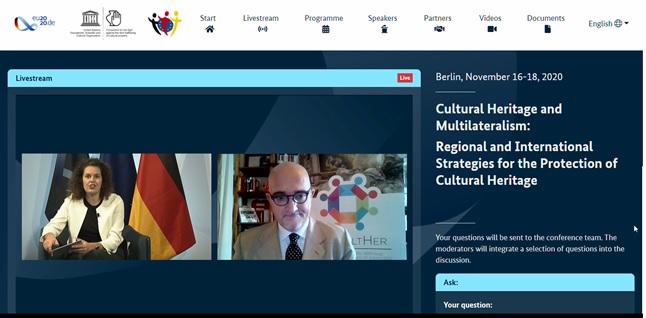From 16 to 18 November Germany’s Presidency of the Council of the European Union organised, in partnership with UNESCO, the European Union and the Council of Europe, the Conference “Cultural Heritage and Multilateralism: Regional and International Strategies for the Protection of Cultural Heritage”.
In the spirit of the celebration of the 50th Anniversary of the 1970 UNESCO Convention on the Means of Prohibiting and Preventing the Illicit Import, Export and Transfer of Ownership of Cultural Property, this three-day online event represented a unique forum for multilateral cultural heritage protection issues that brought together high-ranking representatives from international and nongovernmental organisations. These experts were called to animate panels on topics strictly related to the 1970 UNESCO Convention like the mechanisms against trafficking in cultural property but also on the importance of reinforcing and defining synergies and actions to enhance the sustainable protection of Cultural Heritage (CH) as well as its effective risk management.
PROCULTHER Director, Giovanni De Siervo – Head of the International Relations and Activities Unit – DPC, invited as panel speaker in the session “Risk prevention and management – strategies and synergies”,shared with the audience how the project, pooling together the partners’ capacities for the definition of common language, standards and procedures, is contributing to strengthening the protection of cultural heritage at risk of disaster at national and European level. The main outcome from the session confirmed that PROCULTHER is hitting the right spot: the importance of integrating cultural heritage protection in Disaster risk management (DRM) processes and, in particular, of having shared standards and methodologies to ensure a coordinated and holistic approach to the safeguard of CH in emergency.

In fact, PROCULTHER’s strength lies in a strict collaboration among DRM and CH actors for the promotion of coordinated action and interdisciplinary preparedness and response capacities for a better protection of cultural heritage at risk. Building upon the competences of the Consortium Partners, in a participatory process of scaling-up and capitalisation on the existing capacities for the protection of CH, the project is elaborating a common European methodology along with Standard Operating Procedures (SOPs) digging out relevant good practices and lessons learnt from the project partners.
Moreover, the PROCULTHER project, acting under the Union Civil Protection Mechanism – UPCM, aims at contributing to the effectiveness of the actions undertaken for the protection of CH in emergency by defining an inter-disciplinary module within the framework of the UCPM able to support affected countries or interested International Organisations in the prevention, preparedness and response phases.
To achieve an effective management and protection of CH at risk, PROCULTHER will rely on the direct involvement of relevant stakeholders and interested countries, in particular those participating in the UCPM, in the process of defining, reviewing and testing the tools produced, also through the organisation of training sessions and field exercises. This is why the effects and benefits of all PROCULTHER results and deliverables will not be limited to project partners, as the methodology, tools and SOPs for emergency preparedness and response will be shared with all the UCPM Participating States for their further contribution, updating, improvement and actual implementation.
To highlight the key points to be addressed by the Conference, the project Partners delivered the PROCULTHER CONSORTIUM STATEMENT FOR THE PROTECTION OF CULTURAL HERITAGE AT RISK OF DISASTER that encompasses the cross-cutting issues guiding the project’s activities. For the effective management and protection of cultural heritage at risk, an interdisciplinary approach goes back to back with a structured collaboration and stronger synergies among relevant civil protection and cultural heritage stakeholders, together with the promotion of management models that link short-term relief measures with longer-term development programmes. When a disaster occurs, disaster risk managers are the first responders arriving on the affected sites, for this reason Mr De Siervo stressed the importance of pooling the expertise from both civil protection and cultural heritage experts, as they must work together in a coordinated manner in order to effectively manage the consequences of a disaster impacting on cultural heritage.
At the end, De Siervo recalled that the COVID-19 health crisis forced the Consortium to reschedule the project activities that in the last few months have been slowed down by the restrictive measures linked to this crisis. . Indeed, the restrictions to travel and meetings between experts have limited many fruitful activities such as the organization of training sessions and field exercises necessary to test the effectiveness of the proposed methodologies and the new SOPs developed.
On this Conference’s closing note, the PROCULTHER Consortium Partners renew their invitation to all interested countries and to the international institutions belonging to both the world of civil protection and cultural heritage, to join efforts by sharing the good practices and relevant methodologies, for a better safeguard of cultural heritage at risk.
PROCULTHER CONSORTIUM STATEMENT FOR THE PROTECTION OF CULTURAL HERITAGE AT RISK OF DISASTER
Video of PROCULTHER intervention to the Anniversary of the 1970 UNESCO Convention – part 1
Video of PROCULTHER intervention to the Anniversary of the 1970 UNESCO Convention – part 2
#proculther #culturecannotwait #safeguardculturalheritageatrisk #CulturalHeritage2020 #Multilateralism
@unesco_de @EU_Commission @coe @EU2020DE @ProcultherP






